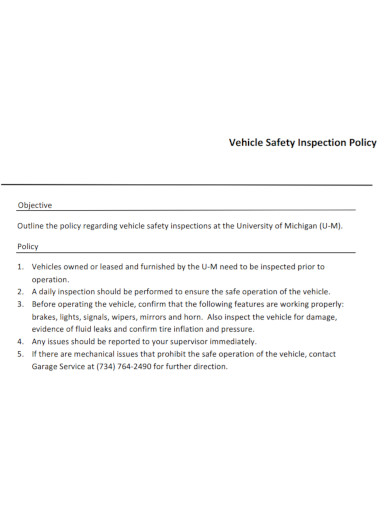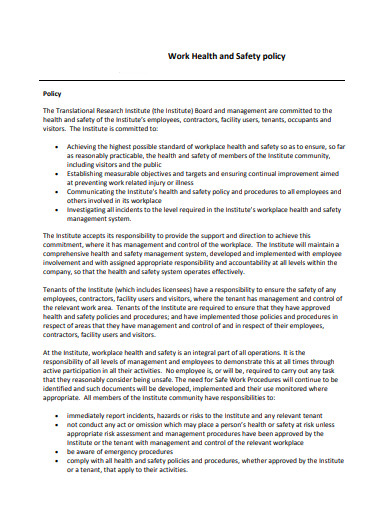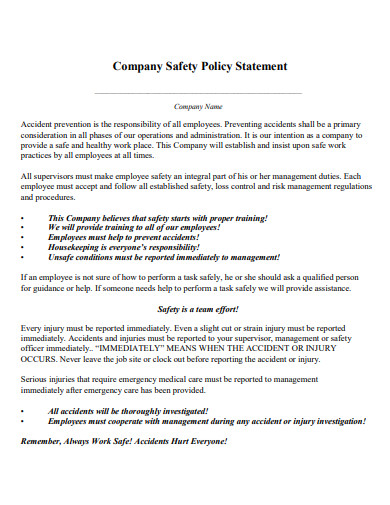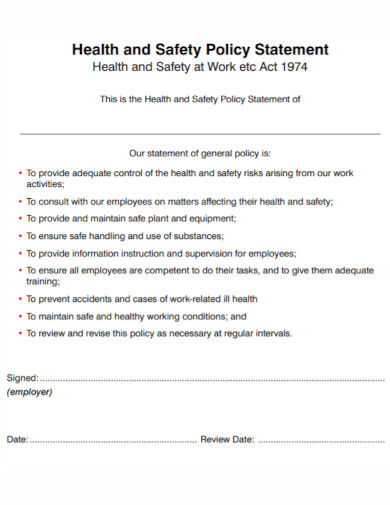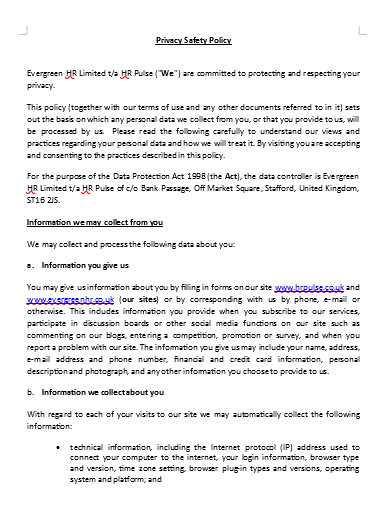As a business owner, your employees’ safety is your number one priority. However, workplace safety isn’t common sense! You can’t expect employees to work safely if you haven’t given them the right tools and training. The most effective way to protect your employees and your business is to have safety policies in place and enforce them.
10+ Safety Policy Samples
1. Health and Safety Policy Template

2. Restaurant General Safety Policy Template
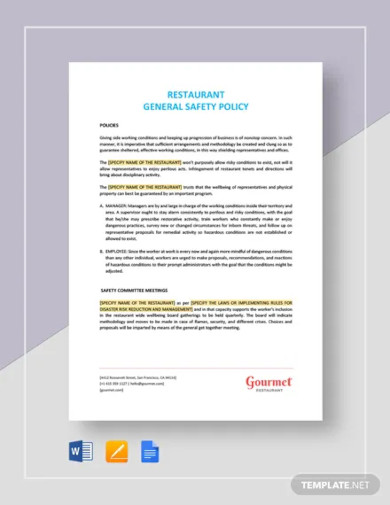
3. Food Safety Policy Template
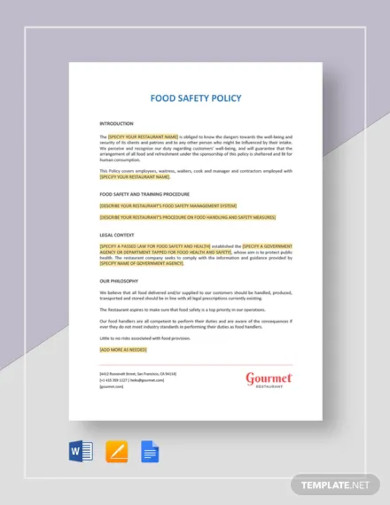
4. School Students Health and Safety Policy
5. Workplace Safety Policy
6. Vehicle Safety Inspection Policy
7. Safety Policy in the Construction Industry
8. Work Health and Safety Policy
9. Company Safety Policy Statement
10. Health and Safety Policy Statement
11. Privacy Safety Policy
What is a Safety Policy?
An organization’s safety policy is a recognized, written statement of its commitment to protect the health and safety of the employees, as well as the surrounding community. The safety policy also details the measures the company takes and will take to protect the life, limb, and health of their employees, often surpassing the requirements set out by the laws or by the standard practices of the industry.
How to Write a Safety Policy?
1. Statement of intent
State your general policy on health and safety at work, including your commitment to managing health and safety and your aims. As the employer or most senior person in the company, you should sign it and review it regularly.
2. Responsibilities for health and safety
List the names, positions and roles of the people in your business who have specific responsibility for health and safety.
3. Arrangements for health and safety
Give details of the practical arrangements you have in place, showing how you will achieve your health and safety policy aims. This could include, for example, doing a risk assessment, training employees and using safety signs or equipment.
FAQs
What details need to be included in a safety policy?
- Statement of the policy – The employer’s commitment to managing health and safety and the goal of the policy
- Responsibility – Stating who is responsible for implementing, enacting, and tracking each element of the policy
- Arrangements or procedures – Outlines the details of procedures including the reduction of hazard policy
It may also include details about the following:
- Employee training
- Use of administrative controls, hazard isolation, locking, warnings, signs and symbols marking hazards, etc.
- Use of personal protective equipment (PPE)
- Removing hazardous materials or replacing them with less harmful alternatives
- Improved lighting and working environment
- Prevention of slip, trip, and fall incidents
What are the top safety policies that should be set in the workplace?
Incident reporting policy
An incident reporting policy outlines your expectations when an employee experiences a safety incident at work. Employees should know to report on-the-job injuries quickly, but this policy goes beyond injury reporting. An “incident” could be a minor, report-only injury or even a near-miss incident in which no one gets hurt. Conducting investigations for all incidents will arm you with the most information to make safety improvements and prevent injuries from happening at all.
Drug and alcohol policy
It might seem like a given that you expect your employees to come to work free from the effects of drugs and alcohol. However, you still need a substance use policy outlining your expectations. Be sure to include the misuse of prescription drugs as well as illegal drugs and alcohol.
This policy is also a great avenue to inform your employees about your drug testing policy. If you conduct post-offer, random, reasonable suspicion or post-incident testing, have your employees sign off on that knowledge. Note that post-incident testing should be done within 24 hours of an incident.
Safe driving policies
Chances are, a good portion of your employees drive a vehicle. Even if they don’t drive for work, they might drive to and from work. Because driving is so common – and so hazardous – we recommend several driving-related safety policies.
- Distracted driving policy: The most common distraction while driving is cellphone use, but drivers can also be distracted by eating, grooming, reaching for objects or even conversations with passengers. Have employees sign an agreement to minimize distractions, and specifically cellphone use, while driving.
- Defensive driving policy: We strongly support defensive driving training for all employees, regardless of role in the company. This policy outlines the tenets of defensive driving, making employees more aware of simple ways they can be safer on the road.
- Seat belt policy: Wearing a seat belt can reduce your risk of death by about 45% in a car crash. While you hope your employees are already wearing their seat belts, it’s important to have them sign a policy promising to do so, every time.
Personal protective equipment (PPE) policy
If your employees regularly do work that requires personal protective equipment, it’s smart to have a policy that states the circumstances under which employees must wear special gear and the proper ways to use it. It’s especially important to review this information with new hires who might not be used to wearing PPE.
Lockout/tagout policy and procedures
A lockout/tagout program protects employees from the unexpected activation or release of energy from machinery. When you train employees on your company’s lockout/tagout procedures, be sure to have them sign an agreement to follow protocol every time they use hazardous equipment.
Transitional duty policy
A return to work program is an important part of claims management. A transitional duty policy lets your employees know that you support an earlier return to work by offering transitional or “light duty” options if an injury prevents them from doing their regular job.
No one likes to be the “safety police” by taking corrective or disciplinary action when an employee violates a policy. But your company’s safety rules are there for a reason: to protect people. If you allow your employees to regularly work in unsafe ways or conditions, someone will get hurt eventually – and that feels much worse than having a reputation as the safety police.
Related Posts
FREE 10+ Plagiarism/Cheating Policy Samples in MS Word | PDF
FREE 50+ Policy Approval Samples in PDF | MS Word
FREE 10+ Related Personnel Policy Samples in MS Word | PDF
FREE 10+ Suspension And Expulsion Policy Samples in MS Word | PDF
FREE 10+ Uniform Complaint Policy and Procedure Samples in PDF
FREE 10+ Bullying Policy Samples in MS Word | PDF
FREE 10+ Fiscal Control Policy Samples & Templates in MS Word | PDF
FREE 10+ Cooperative Policy Samples & Templates in MS Word | PDF
FREE 10+ Disenrollment Policy Samples in MS Word | PDF
FREE 10+ Donation Policy Samples & Templates in MS Word | PDF
FREE 10+ IT and Software Policy Samples in PDF | MS Word | Pages | Google Docs
FREE 50+ Policy Samples in PDF | MS Word
FREE 50+ Membership Policy Samples in PDF
FREE 10+ Shipping Policy Samples in PDF
FREE 10+ Expense Policy Samples in Word | Google Docs | Pages | PDF



